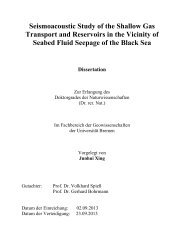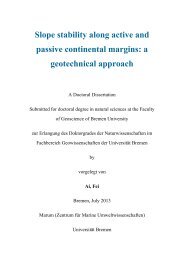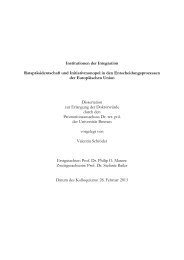aus dem MARUM und dem Fachbereich Geowissenschaften der ...
aus dem MARUM und dem Fachbereich Geowissenschaften der ...
aus dem MARUM und dem Fachbereich Geowissenschaften der ...
Create successful ePaper yourself
Turn your PDF publications into a flip-book with our unique Google optimized e-Paper software.
MARIA S. MERIAN-Berichte, Cruise 20, Leg 4, Bridgetown – Freeport, 15.3.2012 – 7.4.2012<br />
seafloor – as to expect <strong>und</strong>er such vigorous current conditions – high quality video material<br />
could be recorded, showing an amazing CWC ecosystem. The detailed MBES mapping reveal<br />
that these CWC ecosystems are developed on V-shaped ridges - rather than on mo<strong>und</strong>s - that<br />
stretch over several h<strong>und</strong>reds of metres (Fig. 6.1). The ridges are embedded between a steep<br />
slope towards the Campeche Bank in the west and a major drift sediment body in the east (as<br />
already described by Hübscher et al., 2010). They follow the main current direction towards the<br />
NW. In addition, a second orientation becomes evident with ridges stretching towards the NE.<br />
Often both directions are merged thereby forming the V-shaped ridges pointing with the tip to<br />
the NW. During the ROV dives, it has been observed that the morphology of these ridges is<br />
mostly rather steep with differences between ridge crests and bases of up to 30 m. Living corals<br />
occur at the highest parts, followed downslope by a zone of coral rubble and by plain soft<br />
sediments in the lower parts of the ridges and in between them. An overview map of the<br />
Campeche Bank working area with all the sampling stations is given in Fig. 6.1.<br />
Fig. 6.1 Overview map of the Campeche Bank working area showing all sampling sites and ROV dive tracks<br />
(GeoB station Numbers are indicated) conducted during cruise MSM20-4.<br />
6.1.2. Campeche Bank: The Water Column Structure<br />
(Christian Dullo, Thorsten Garlichs, Silke Glogowski)<br />
In the Yucatan Strait (GeoB 16303), the uppermost 70 m of the water column is characterized by<br />
the occurrence of relatively fresh water with salinities less than 35.89. This shallow water mass<br />
is called Caribbean Water (CW) and believed to be a mixture of the Amazon and Orinoco River<br />
outflow, as well as North Atlantic surface water. A salinity maximum (about 36.9) between 100<br />
to 135 m has been measured and is characteristic for the Subtropical Un<strong>der</strong> Water (SUW). This<br />
water mass is formed in the central tropical Atlantic, where evaporation exceeds precipitation. It<br />
17

















